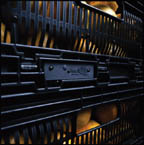Tag! RFID's it

Radio Frequency (RF) technology has been around for years. It has evolved into a workhorse in many food plants and continues to grow in both acceptance and value.
According to Kara Romanow, research director at AMR Research, "Several forces are driving the adoption of RF in food plants. First, as systems take on more of the management load, the need for data has increased, plus puts a premium on the accuracy and timelines. Second, RF technology continues to evolve with new form factors and functions that increase its applicability for use in the plant. The drive to increase productivity and reduced cost also continues the push for more effective, lower cost approaches."

Increasing functionality
An RF solution requires multiple technologies. A source must be available to be read: a barcode, a scale reading or an RF tag. A device like a scanner or handheld PC must read the data. The third component is a system that can accept the information, verify its accuracy and use it effectively.
RFID devices, while still relatively expensive for most applications, have gone down in price and increased in functionality. Most equipment (scales, batching systems, etc.) now includes interface points as standard features. In-line bar code printers can be combined with various types of equipment to add machine readable information to pallets, totes, and end products. Further, finger-mounted readers allow workers to point to the barcode and RFID readers can function without a direct line of sight. And we're seeing an increase in portability. Handheld devices provide a PC that can be used on forklifts, placed on the user's belt or carried by hand. Many plant level information systems also include software functions to convert the stream of data from the plant floor into transactions for inventory, production control, quality, shipping and other functions.
Joining the ranks
But Wal-Mart and its suppliers aren't the only companies turning to RFID to increase efficiency. In the UK, the name George Adams is synonymous with pork pie retailing. The company's product range has expanded to a wide variety of meat and sausage, including Adams Lincolnshire Pork Sausages and Pork Pies and a large selection of pastry and fried products.George Adams' Ruskington plant was the first company in the food manufacturing industry to go live with end-to-end data from the production line. For data collection, the plant used barcode labels to track batches of meat through the process using touch screen PCs from Nematron and handheld scanners from Intermec via an RF network. "The Ruskington plant is one of the first completely RF networked systems in food manufacturing," says Gerry Boundy of SSI, a software supplier to the plant. "This significantly reduces the need for cabling, which is a health and safety issue, and allows greater flexibility in the factory. The hardware is rated IP65 - a standard rating for the food industry - ensuring that it will not contaminate food and that it can withstand the rigors of the environment."
Similarly, Ganong, a Canadian manufacturer of gift box chocolates, fruit snacks and sugar confectionery serving mass merchandisers, drug chains and grocery stores, uses Intermec Antares Trakker 2425 units with built-in laser scanners for barcodes. All of its storage locations are barcode marked. Ganong has eight handheld units on the floor tracking inventory, production and warehouse movements. They operate through six Intermec 2100D Industrial Access Points throughout the plant and warehouse area that interface with its Adonix X3 ERP system through a data collection module.
According to Marc Lefebvre, the processor's vice president and CIO, "Ganong sees greatly improved accuracy and timeliness of production recording through the use of the plant data collection, thereby improving the production planning process. This is one feature of the system from which we derived benefits immediately."
Better tracking reduces costs
Paramount Farms, the world's largest supplier of almonds and pistachios, also knows the value of RFID firsthand. The company grows and processes about 60 percent of the U.S. pistachio crop. "The big challenge with a pistachio harvest is that once it starts, there's no way to stop it," said Dave Szeflin, Paramount's vice president of operations. "In our average harvest season, incoming green product totals a half billion pounds over a six-week period. Given this time constraint, as we increase our production goals, our efficiency and productivity must likewise increase."With an RFID system from Intermec Technologies, Paramount found it could scrap plans to enlarge the company's scale house because the RFID system helped cut initiation time for processing new crop loads by 60 percent. Eleven handheld computers, three access points and three RFID tag readers supply the grower with the tools to not only keep up with business, but also to expand it. The increase in receiving efficiency benefited equipment logistics, allowing a reduction of 30 percent in leased trailer usage. The flow of information has never been better. "We are more confident than ever of our data system's integrity and the accuracy of the information, since more of the data is collected using radio-frequency tags and barcode scanners," said Andy Anzaldo, director of grower relations at Paramount. As RF and RFID evolve, the increased functionality and efficiency they provide could mean reduced costs for those who adopt the technology. Further, the more integration that can be engineered into the technology should increase long-term savings for end users.
Olin Thompson is a consultant who specializes in the application of information technology in the food industry. He is the founder of The Food CIO Forum (www.foodcioforum.com).
Looking for a reprint of this article?
From high-res PDFs to custom plaques, order your copy today!


